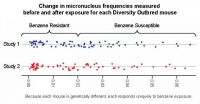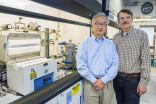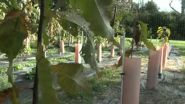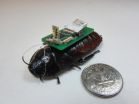(Press-News.org) A genetically diverse mouse model is able to predict the range of response to chemical exposures that might be observed in human populations, researchers from the National Institutes of Health have found. Like humans, each Diversity Outbred mouse is genetically unique, and the extent of genetic variability among these mice is similar to the genetic variation seen among humans.
Using these mice, researchers from the National Toxicology Program (NTP), an interagency program headquartered at the National Institute of Environmental Health Sciences (NIEHS), were able to identify specific genes or chromosomal regions that make some mice more susceptible, and others more resistant, to the toxic effects of benzene. Benzene is a common air pollutant and human carcinogen found in crude oil, gasoline, and cigarette smoke, and naturally produced by wildfires and volcanoes.
The scientists found that, like humans, each Diversity Outbred mouse developed at The Jackson Laboratory, Bar Harbor, Maine, responded to the effects of the chemical exposure differently. Exposure responses were assessed by measuring the frequency of micronucleated red blood cells, a biological marker of chromosomal damage, which is a hallmark of benzene exposure. The researchers measured the levels of this biomarker in each mouse before and after exposure.
Some mice demonstrated extraordinary sensitivity to the exposure, while others showed no response. The range of response from lowest to highest was approximately 5-fold. Since the researchers knew the genetic makeup of each mouse, they could pinpoint the regions involved in susceptibility or resistance to the chemical exposure, and then look for related genetic regions in human chromosomes.
"This paper points out the significant genetic differences that are found throughout every population that must to be taken into account when extrapolating data from animals to humans," said Linda Birnbaum, Ph.D., director of NTP and NIEHS. "The Diversity Outbred mouse is a useful model for predicting the range of response that might be observed in humans following exposure to a chemical."
Benzene was selected by NTP as a case study for testing the mouse model, because there is an abundance of animal and human toxicity data for comparison. Benzene can affect people differently, depending on the level and duration of exposure, making it important to accurately estimate the levels at which it may cause harm to the most susceptible individuals.
"These genetically diverse mice provided a reproducible response to benzene exposure across two independently exposed groups, suggesting that each group of genetically unique mice demonstrated the same range of differential susceptibility, much like what you would find in human epidemiology studies," said Jef French, Ph.D., lead author on the paper. "It's important to be able to accurately measure the impact of exposure and to develop appropriate permissible safety levels for toxic compounds. This model can help us do that with greater accuracy."
These results may lead to further research to better understand genetically regulated responses to toxicity in humans, as well as mechanisms of susceptibility and resistance to environmental exposures as they relate to disease. "In addition to informing the design of human epidemiology studies evaluating associations between chemical exposures and biological effects in diverse populations, the Diversity Outbred mouse model may also provide valuable data for use by regulators and manufacturers conducting chemical risk assessments," said co-author Kristine Witt of NTP.
INFORMATION:
The paper is available online in the journal Environmental Health Perspectives. In addition to NIEHS and NTP, researchers from The Jackson Laboratory, ILS Inc., and Alion Science and Technology Corporation also collaborated in the research effort. The National Institute of General Medical Sciences, part of NIH, also helped support the study (grants P50GM076468 and R01GM070683).
Next spring, the NIEHS Division of Extramural Research and Training plans to hold a meeting to look at the Diversity Outbred mouse model and other population-based rodent models that can be used to advance the field of environmental health sciences.
Reference: French JE, Gatti DM, Morgan DL, Kissling GE, Shockley KR, Knudsen GA, Shepard KG, Price HC, King D, Witt KL, Pedersen LC, Munger SC, Svenson KL, Churchill GA. 2014. Diversity Outbred mice identify population based exposure thresholds and genetic factors that influence benzene-induced genotoxicity. Environ Health Perspect; doi:10.1289/ehp.1408202.
NIEHS supports research to understand the effects of the environment on human health and is part of NIH. For more information on environmental health topics, visit http://www.niehs.nih.gov. Subscribe to one or more of the NIEHS news lists to stay current on NIEHS news, press releases, grant opportunities, training, events, and publications.
NTP is a federal, interagency program, headquartered at the NIEHS, whose goal is to safeguard the public by identifying substances in the environment that may affect human health. For more information about NTP and its programs, visit http://ntp.niehs.nih.gov/.
About the National Institutes of Health (NIH): NIH, the nation's medical research agency, includes 27 Institutes and Centers and is a component of the U.S. Department of Health and Human Services. NIH is the primary federal agency conducting and supporting basic, clinical, and translational medical research, and is investigating the causes, treatments, and cures for both common and rare diseases. For more information about NIH and its programs, visit http://www.nih.gov.
Contact:
Robin Mackar
rmackar@niehs.nih.gov
919-541-0073
WASHINGTON, D.C., November 6, 2014--Short-term certificate programs at community colleges offer limited labor-market returns, on average, in most fields of study, according to new research published today in Educational Evaluation and Policy Analysis (EEPA), a peer-reviewed journal of the American Educational Research Association. The results of the study, which focused on community college programs in Washington State, are in line with recent research in other states (Kentucky, North Carolina, and Virginia) that found only small economic returns from short-term programs. ...
WASHINGTON, DC (November 6, 2014)--In honor of Veterans Day, the peer-reviewed journal Women's Health Issues (WHI) today released a new Special Collection on women veterans' health, with a focus on mental health. The special collection also highlights recent studies addressing healthcare services, reproductive health and cardiovascular health of women veterans.
"In recent years, we have seen the Veterans Administration working to improve care and health outcomes of women veterans and service members," said Chloe Bird, editor-in-chief of Women's Health Issues. "The studies ...
Paramedics respond to a 911 call to find an elderly patient who's having difficulty breathing. Anxious and disoriented, the patient has trouble remembering all the medications he's taking, and with his shortness of breath, speaking is difficult. Is he suffering from acute emphysema or heart failure? The symptoms look the same, but initiating the wrong treatment regimen will increase the patient's risk of severe complications.
Researchers from MIT's Research Laboratory of Electronics, working with physicians from Harvard Medical School and the Einstein Medical Center in ...
CORVALLIS, Ore. – Power outages have never been more costly. Electricity is critical to communication, transportation, commerce and national security systems, and wide-spread or prolonged outages have the potential to threaten public safety and cause millions, even billions, of dollars in damages.
"It doesn't seem that dire until a storm hits, or somebody makes a mistake, and then you are risking a blackout," said Inara Scott, an assistant professor in the College of Business at Oregon State University.
"You have to consider the magnitude of the potential harm ...
High-speed reading of the genetic code should get a boost with the creation of the world's first graphene nanopores - pores measuring approximately 2 nanometers in diameter - that feature a "built-in" optical antenna. Researchers with Berkeley Lab and the University of California (UC) Berkeley have invented a simple, one-step process for producing these nanopores in a graphene membrane using the photothermal properties of gold nanorods.
"With our integrated graphene nanopore with plasmonic optical antenna, we can obtain direct optical DNA sequence detection," says Luke ...
ATLANTA, GA (November 6, 2014) – Whether allergy sufferers have symptoms that are mild or severe, they really only want one thing: relief. So it's particularly distressing that the very medication they hope will ease symptoms can cause different, sometimes more severe, allergic responses.
According to a presentation at the American College of Allergy, Asthma and Immunology (ACAAI) Annual Scientific Meeting, an allergic response to a medication for allergies can often go undiagnosed. The presentation sheds light on adverse responses to topical skin preparations; ...
Berlin, Germany (November, 2014) – A specimen of the ancient horse Eurohippus messelensis has been discovered in Germany that preserves a fetus as well as parts of the uterus and associated tissues. It demonstrates that reproduction in early horses was very similar to that of modern horses, despite great differences in size and structure. Eurohippus messelensis had four toes on each forefoot and three toes on each the hind foot, and it was about the size of a modern fox terrier. The new find was unveiled at the 2014 Annual Meeting of the Society of Vertebrate Paleontology ...
VIDEO:
Scientists at the SUNY College of Environmental Science and Forestry (ESF) are growing the first American chestnut trees that can withstand the blight that virtually eliminated the once-dominant tree from...
Click here for more information.
SYRACUSE, N.Y. — Scientists at the SUNY College of Environmental Science and Forestry (ESF) are growing the first American chestnut trees that can withstand the blight that virtually eliminated the once-dominant tree from the eastern ...
WASHINGTON, DC, November 6, 2014 -- Go to almost any American high school and the elements of teen social networks become quickly apparent: the cliques, the pecking orders, and the varying degrees of self-segregation by race, age, gender, and social status.
For years, sociologists have identified seemingly universal human instincts that spur this kind of sorting. These include the desires for familiarity and certainty; for control and dominance; and for security and support.
But as ubiquitous as those instincts are, students in some schools form more cliquish, hierarchical, ...
North Carolina State University researchers have developed technology that allows cyborg cockroaches, or biobots, to pick up sounds with small microphones and seek out the source of the sound. The technology is designed to help emergency personnel find and rescue survivors in the aftermath of a disaster.
The researchers have also developed technology that can be used as an "invisible fence" to keep the biobots in the disaster area.
"In a collapsed building, sound is the best way to find survivors," says Dr. Alper Bozkurt, an assistant professor of electrical and computer ...




